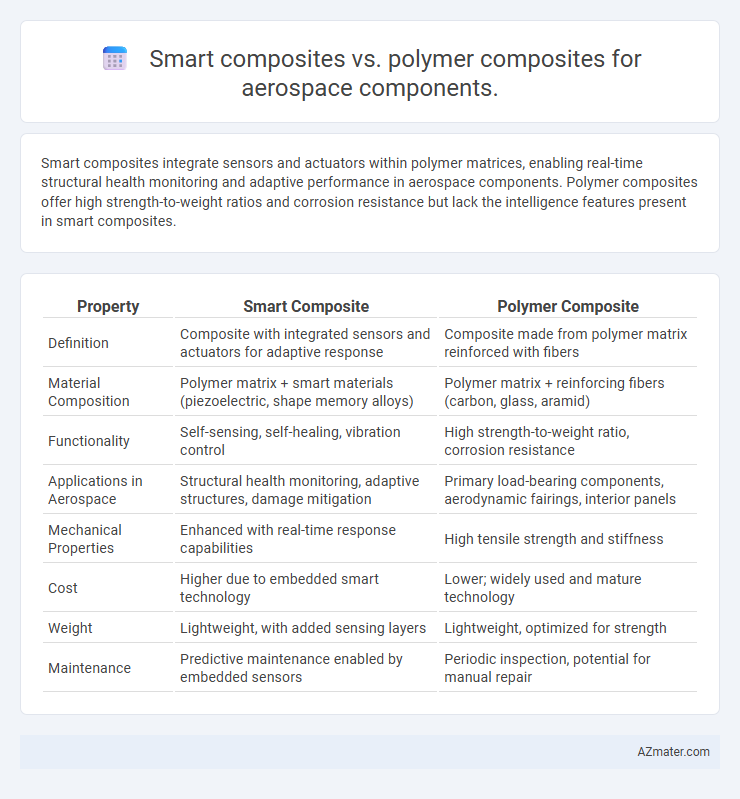Smart composites integrate sensors and actuators within polymer matrices, enabling real-time structural health monitoring and adaptive performance in aerospace components. Polymer composites offer high strength-to-weight ratios and corrosion resistance but lack the intelligence features present in smart composites.
Table of Comparison
| Property | Smart Composite | Polymer Composite |
|---|---|---|
| Definition | Composite with integrated sensors and actuators for adaptive response | Composite made from polymer matrix reinforced with fibers |
| Material Composition | Polymer matrix + smart materials (piezoelectric, shape memory alloys) | Polymer matrix + reinforcing fibers (carbon, glass, aramid) |
| Functionality | Self-sensing, self-healing, vibration control | High strength-to-weight ratio, corrosion resistance |
| Applications in Aerospace | Structural health monitoring, adaptive structures, damage mitigation | Primary load-bearing components, aerodynamic fairings, interior panels |
| Mechanical Properties | Enhanced with real-time response capabilities | High tensile strength and stiffness |
| Cost | Higher due to embedded smart technology | Lower; widely used and mature technology |
| Weight | Lightweight, with added sensing layers | Lightweight, optimized for strength |
| Maintenance | Predictive maintenance enabled by embedded sensors | Periodic inspection, potential for manual repair |
Introduction to Aerospace Composites
Aerospace composites are crucial for enhancing performance by combining materials to achieve superior strength-to-weight ratios. Smart composites integrate sensors and actuators within polymer matrices, enabling real-time monitoring and adaptive responses in aerospace components. Polymer composites, consisting of fiber reinforcements embedded in polymer resins, provide lightweight structural support essential for aircraft efficiency and durability.
Defining Smart Composites
Smart composites integrate sensors and actuators within polymer matrices, enabling real-time monitoring and adaptive response to environmental changes, which enhances aerospace component performance and safety. Polymer composites, consisting of reinforcing fibers embedded in a polymer resin, offer high strength-to-weight ratios and corrosion resistance but lack intrinsic sensing or adaptive capabilities. The key distinction lies in smart composites' ability to self-diagnose and adapt, making them indispensable for advanced aerospace structural health monitoring and maintenance.
Overview of Polymer Composites
Polymer composites in aerospace components are predominantly comprised of a polymer matrix reinforced with fibers such as carbon, glass, or aramid, offering high strength-to-weight ratios essential for aircraft performance. These composites exhibit excellent corrosion resistance, fatigue durability, and design flexibility, making them ideal for primary and secondary structural applications. The integration of thermosetting resins like epoxy or thermoplastic matrices ensures enhanced mechanical properties and thermal stability required to withstand extreme aerospace environments.
Key Material Properties Comparison
Smart composites exhibit adaptive properties such as shape memory and self-healing capabilities, making them ideal for aerospace components requiring dynamic response to environmental changes. Polymer composites, typically reinforced with carbon or glass fibers, offer high strength-to-weight ratios and excellent corrosion resistance but lack intrinsic sensing or actuation functions. Key material properties comparison highlights smart composites' multifunctionality and damage tolerance, whereas polymer composites excel in stiffness, durability, and cost-effectiveness for aerospace structural applications.
Structural Performance in Aerospace Applications
Smart composites offer enhanced structural performance in aerospace applications by integrating sensors and actuators that enable real-time health monitoring and adaptive responses to stress, improving safety and durability. Polymer composites provide excellent strength-to-weight ratios and corrosion resistance, making them ideal for lightweight aerospace components, but lack the inherent adaptability of smart composites. The choice between smart and polymer composites depends on specific structural requirements, with smart composites excelling in dynamic environments requiring active feedback and polymer composites favored for static load-bearing elements.
Weight Reduction and Fuel Efficiency
Smart composites integrate sensors and actuators within polymer composites, enabling real-time structural health monitoring and adaptive performance, which enhances durability and reduces maintenance weight in aerospace components. Polymer composites offer significant weight reduction compared to traditional metals, directly contributing to improved fuel efficiency by lowering the overall aircraft mass. The combination of smart composites' functional intelligence with polymer composites' lightweight properties optimizes aerospace designs for maximum weight savings and fuel economy.
Integration of Sensing and Self-Healing Capabilities
Smart composites in aerospace components integrate embedded sensors and self-healing materials, enabling real-time structural health monitoring and autonomous damage repair to enhance safety and prolong service life. Polymer composites, while offering high strength-to-weight ratios, typically lack intrinsic sensing and self-healing functionalities, requiring external systems for damage detection and maintenance. Advancements in smart composite technology leverage nanoscale sensors and microencapsulated healing agents, optimizing performance and reducing maintenance costs in aerospace applications.
Manufacturing and Cost Considerations
Smart composites incorporate sensors and actuators within the material, enabling real-time structural health monitoring and adaptive performance, which improves safety and reduces maintenance costs in aerospace components. Polymer composites, widely used due to their lightweight and high strength-to-weight ratio, offer cost-effective manufacturing through established processes like resin transfer molding and automated fiber placement. While smart composites involve higher initial investment and complex integration, their ability to enhance functionality can justify the cost in critical aerospace applications requiring advanced performance and lifecycle management.
Durability and Maintenance Factors
Smart composites in aerospace components exhibit superior durability due to their integrated sensing capabilities, enabling real-time damage detection and structural health monitoring, which significantly reduces maintenance frequency and cost. Polymer composites, while lightweight and corrosion-resistant, often require scheduled inspections and repairs due to their susceptibility to fatigue and environmental degradation. The enhanced self-sensing properties of smart composites contribute to improved lifecycle performance and reliability, offering a strategic advantage over conventional polymer composites in demanding aerospace applications.
Future Trends in Aerospace Composite Technology
Smart composites integrate sensors and actuators within polymer composite matrices, enabling real-time health monitoring and adaptive response in aerospace components. Polymer composites, primarily carbon fiber reinforced polymers, continue to advance in strength-to-weight ratios and thermal resistance, driving efficiency and durability improvements. Future trends emphasize multifunctionality, self-healing properties, and enhanced data integration to optimize aerospace performance and maintenance.

Infographic: Smart composite vs Polymer composite for Aerospace component
 azmater.com
azmater.com